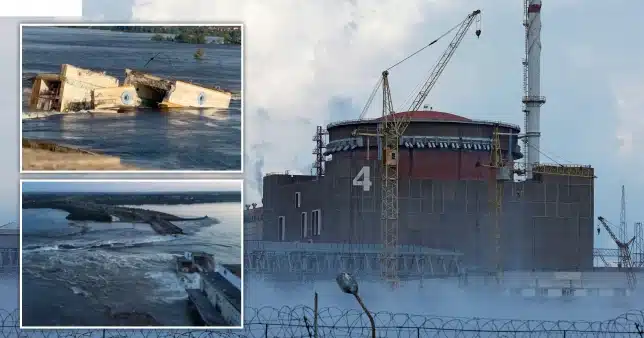Following explosions at a significant dam and hydroelectric facility that resulted in widespread flooding and an ecological catastrophe, Russia may be planning to destroy the Zaporizhzhia Nuclear Power facility.
Volodymyr Zelensky, the president of Ukraine, charged Russia with setting off a “environmental bomb of mass destruction” at the Nova Kakhovka dam in Kherson yesterday, causing “catastrophic” flooding across the area.
According to Zelensky, “one of Ukraine’s largest water reservoirs was deliberately destroyed.” “Thousands of people have been left without access to clean drinking water on a regular basis.”
Meanwhile Ukraine’s top security official Oleksiy Danilov said the dam blast was ‘a fundamentally new stage of Russian aggression,’ and warned that the nearby nuclear power plant in Zaporizhzhia could be Putin’s next target.

The Zaporizhzhia Nuclear Power Plant (ZNPP) has been under Russian control since the start of the war, and is reliant on water from the dam to cool its reactors.
‘It is a fact there are explosives [at the occupied Zaporizhzhia plant],’ Danilov told the Times, and said since Putin had the hydroelectric power plant blown up on his demand, he’s ‘ready to do anything.’
The plant has been shelled repeatedly throughout the war, sparking fears of a nuclear meltdown last year when rockets hit one of the plant’s reactors, which both Ukraine and Russia claimed the other was responsible for.
Russian forces have been accused of converting the plant into a military base and are ‘sufficiently protected’ from being re-captured by force, pro-Kremlin media reports.
Raphael Grossi, head of the International Atomic Energy Agency (IAEA) said this morning that the breach poses no short term risk to the ZNPP, but admitted the situation was making an already very difficult and unpredictable nuclear safety and security situation even worse.
The dam’s reservoir provides water used for the essential cooling of the six reactors at Europe’s biggest nuclear power plant, and is set to displace tens of thousands of people.
Dramatic scenes from throughout Kherson saw entire homes swept away by the dam blast, while in some communities people were forced to spend the night on the roof of their homes to avoid getting swept away.
The cause of the blasts is not yet clear, although Ukraine warned late last year that Russian forces had mined the dam as they retreated from Kherson.
At an emergency security council meeting yesterday, President Zelensky blamed the breach on ‘Russian terrorists’, saying it underlined the need for Ukraine to liberate all its territory from its neighbour’s occupation.
The President condemned the incident as the ‘largest human-made environmental disaster in Europe in decades’.
Russia has accused Kyiv of blowing up the dam themselves to distract from what they perceive to be a failing Ukrainian counteroffensive, using shells to breach the dam walls.
But although the cause of the blast is not yet clear, Ukraine warned late last year that Russian forces had mined the dam as they retreated from Kherson and Ukraine’s state hydroelectric company said the Kakhovka plant was destroyed by an explosion in the engine room- suggesting it was attacked from within rather than by external strikes.
‘Russia has controlled the dam and the entire Kakhovka hydro power plant for more than a year,’ Zelensky said.
‘It is physically impossible to blow it up somehow from the outside, by shelling. It was mined by the Russian occupiers. And they blew it up.’
Britain’s Ministry of Defense, which has regularly issued updates about the war, said the Kakhovka reservoir was at ‘record high’ water levels before the breach.
While the dam wasn’t entirely washed away, the ministry warned that its structure ‘is likely to deteriorate further over the next few days, causing additional flooding.’
Ukraine’s minister of internal affairs said Russian shelling was hampering attempts to evacuate people from the flooded regions.
‘The Russian military continues to shell territory where evacuation measures are being carried out,’ he told Ukrainian television, saying two policemen had been wounded by artillery fire.
The floodwaters have also washed landmines from positions on the Russian-controlled eastern bank, creating an additional danger for those seeking to escape, he said.
Kyiv said 150 tonnes of engine oil had spilled into the river, and the agricultural ministry said about 10 thousand hectares of farmland on the right bank of the river would be flooded and ‘several times more’ on the left bank.
Rishi Sunak said it was too soon to make a ‘definitive judgement’ that Moscow’s forces were responsible.
Sunak added: ‘But if it’s intentional, it would represent, I think, the largest attack on civilian infrastructure in Ukraine since the start of the war, and just demonstrate the new lows that we would have seen from Russian aggression.’

